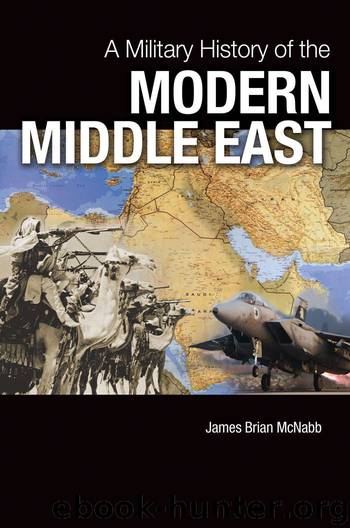A Military History of the Modern Middle East by James McNabb

Author:James McNabb [McNabb, James]
Language: eng
Format: azw3
Publisher: ABC-CLIO
Published: 2017-03-31T04:00:00+00:00
OPERATION EARNEST WILL
As the deal was to take effect within 10 days, the Reagan administration was sufficiently motivated for approving the Kuwaiti request and subsequently moved within 5 days, closing a deal to reflag the Kuwaiti tankers with an American flag, thereby co-opting the Soviets.25 The Kuwaiti tanker fleet at the time consisted of 22 ships, and the United States placed its flag on 11 tankers. The reflagging and follow-on naval convoying activities became part of Operation Earnest Will, which lasted from July 24, 1987, to September 26, 1988—the largest naval convoying of ships since the Second World War. Any attack on such flagged ships could be treated as an attack on the United States and would provide the legal basis for military retaliation.
Such support neutralized a key point of leverage the Iranians had over Saddam by virtue of its successful military operations aimed at blocking the Shatt al-Arab waterway—stopping his ability to generate revenue by the export of oil. The Kuwait-U.S. move ensured an Iraqi stream of revenue for the duration of the war and served to frustrate the Iranian leadership and its desire to see the war conclude on its terms. In short, the United States, by conducting Operation Earnest Will, moved to internationalize the Iran-Iraq conflict, placing the Iranian leadership on the horns of a precarious dilemma: escalate and be faced with a military conflict involving the United States and its associated allies, or accept that Iraqi oil will make it into the international marketplace, ensuring that Baghdad continued to have a steady stream of revenue to continue fighting. The escalation of what became known as the “tanker war” during the Iran-Iraq conflict was actually under way prior to the initiation of Operation Ernest Will, as Iraq attacked Iranian tankers, including the key oil terminal at Kharg Island, in 1984. Iran responded by attacking tankers carrying Iraqi oil from Kuwait followed by a precipitous escalation that began targeting any tanker belonging to Gulf countries supporting Iraq.
Within the Gulf, on May 17, 1987, an Iraqi F1 Mirage jet reportedly (at the height of the Iran-Contra scandal, which had become public in November 1986) misidentified the USS Stark (FFG 31)—a Perry-class frigate—and fired two “Exocet” AM39 air-to-surface missiles (range of 40 miles and each carrying a 352-pound warhead, both jet and missile French-built), which killed 37 and wounded 21 aboard the Stark. The United States publicly considered this act to be a mistake, as the Iraqis at the time were engaging a nearby Iranian warship.
Further dangerous escalatory moves occurred during the Iran-Iraq War when Iran began mining Gulf waters to interdict ships moving in support of Iraq. The USS Samuel B. Roberts (FFG-58) was hit by an Iranian mine on April 14, 1988, 65 miles east of Bahrain, with the resulting explosion ripping a massive hole in the ship’s hull. The United States responded by launching Operation Praying Mantis—its largest action involving surface warships since World War II—four days later when it attacked two Iranian frigates (Sabalan and Sahand) and fired on Iranian oil platforms in the Sassan and Sirri oil fields.
Download
This site does not store any files on its server. We only index and link to content provided by other sites. Please contact the content providers to delete copyright contents if any and email us, we'll remove relevant links or contents immediately.
| Africa | Americas |
| Arctic & Antarctica | Asia |
| Australia & Oceania | Europe |
| Middle East | Russia |
| United States | World |
| Ancient Civilizations | Military |
| Historical Study & Educational Resources |
Empire of the Sikhs by Patwant Singh(23021)
The Wind in My Hair by Masih Alinejad(5056)
Rise and Kill First by Ronen Bergman(4739)
The Templars by Dan Jones(4656)
The Rape of Nanking by Iris Chang(4165)
12 Strong by Doug Stanton(3526)
Blood and Sand by Alex Von Tunzelmann(3164)
Babylon's Ark by Lawrence Anthony(2648)
The History of Jihad: From Muhammad to ISIS by Spencer Robert(2599)
No Room for Small Dreams by Shimon Peres(2343)
The Turkish Psychedelic Explosion by Daniel Spicer(2330)
Inside the Middle East by Avi Melamed(2325)
Gideon's Spies: The Secret History of the Mossad by Gordon Thomas(2319)
Arabs by Eugene Rogan(2279)
The First Muslim The Story of Muhammad by Lesley Hazleton(2245)
Come, Tell Me How You Live by Mallowan Agatha Christie(2228)
Bus on Jaffa Road by Mike Kelly(2123)
Kabul 1841-42: Battle Story by Edmund Yorke(2003)
1453 by Roger Crowley(1994)
